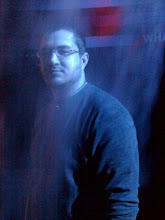Errol Morris demands patience in his audience. There is, however, clearly much more to The Thin Blue Line than the idea that “good things come to those who wait.” I had started watching or seen parts of the film probably five or six times before actually sitting down to watch the entire piece. Once I fell asleep, once something else came up, once I think I just was not in the mood and got bored. Yet I kept coming back to the film for some reason (I already knew the story of what happens), feeling compelled to watch the documentary from start to finish. I was glad to have it screened in class.
What seems to work so well, and what also seems to require the most patience from the audience, is the way in which Morris interviews his subjects. They are allowed to slowly ramble towards a statement that might provide the most interest or insight. Neither Randall Adams or David Harris starts out with much interesting to say. They do provide exposition for the story in that they explain their version of the facts of what happened leading up to the shooting of a Dallas Police officer. Yet as the story progresses their statements seem to become more vague, leaving the audience to wonder where the story will go.
To provide some direction and answers Morris introduces a host of experts on the case. Investigating officers, detectives, attorneys, and the judge in the case are all interviewed, and provide fairly straightforward accounts of what they believe happened. Initially, all of these sources seem credible, and while their on screen testimony may not match with that of Adams or Harris, they are positioned in the outset of the film as authority figures. Neither Adams nor Harris appear to be particularly trustworthy or believable compared to many of the other people involved in the case. They are both seen in prison garb, Adams clearly being held in a penitentiary or jail, Harris in front of a strange, colorful background that fails to hide the fact he is wearing bright orange.
Morris seems to know exactly when the audience is at the point of simply saying “OK, I get it.” These points occur several times throughout the film, and are immediately followed by an interview, piece of evidence, or testimony that completely turns things upside down for the viewer. To construct the narrative of the film in such a way that resonates so strongly with so many people is certainly not easy. It doesn’t feel like the classic double or triple-cross used in thrillers and mysteries, however (although the reenactments, music, and tone displayed in the film often allude to these genres). Morris manages to create a sense of doubt throughout the piece that never really goes away for the viewer. Even when all of the facts seem to point to only one answer, there is a lingering doubt in the viewers mind as to what they can truly believe.
As many effective documentaries do, The Thin Blue Line keeps you thinking throughout the entire film. There is no time to relax, no time to escape, no time to turn off the brain and be entertained or simply led through a narrative. Morris imparts so much meaning in every scene of the film that nothing less then full intellectual involvement from viewers will result in a worthwhile cinema experience. Perhaps this is why I had such trouble completing the film before seeing it from start to finish in class last week; there was always something else on my mind, and I could never give my full attention to what I was watching and listening to.
I found The Thin Blue Line to be particularly difficult to write about and respond to without simply outlining the plot structure. I am not quite sure why this is. I do not know if the film is so perfect that I have nothing to say about it, or if it is so demanding of the viewer that whatever I say will not live up to the ideas about the U.S. judicial system and the ultimate power of documentary that it displays.
Monday, October 26, 2009
Subscribe to:
Post Comments (Atom)

No comments:
Post a Comment